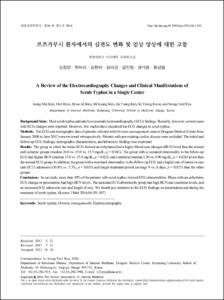KUMEL Repository
1. Journal Papers (연구논문)
1. School of Medicine (의과대학)
Dept. of Internal Medicine (내과학)
쯔쯔가무시 환자에서의 심전도 변화 및 임상 양상에 대한 고찰
- Keimyung Author(s)
- Kim, Hyun Ah; Kim, Mi Kyung; Kim, Jin Young; Kwon, Ki Young; Ryu, Seong Yeol
- Department
- Dept. of Internal Medicine (내과학)
- Journal Title
- 대한내과학회지
- Issued Date
- 2014
- Volume
- 86
- Issue
- 3
- Abstract
- Background/Aims: Most scrub typhus patients have normal electrocardiography (ECG) findings. Recently, however, several cases
with ECG changes were reported. However, few studies have examined the ECG changes in scrub typhus.
Methods: The ECG and demographic data of patients infected with Orientia tsutsugamushi seen at Dongsan Medical Center from
January 2008 to June 2012 were reviewed retrospectively. Patients with pre-existing cardiac disease were excluded. The initial and
follow-up ECG findings, demographic characteristics, and laboratory findings was examined.
Results: The group in which the initial ECG showed an arrhythmia had a higher blood urea nitrogen (BUN) level than the normal
and ischemic groups (median 26.0 vs. 15.0 vs. 15.5 mg/dL, p = 0.041). The group with a sustained abnormality in the follow-up
ECG had higher BUN (median 17.0 vs. 15.0 mg/dL, p = 0.022) and creatinine (median 1.30 vs. 0.90 mg/dL, p = 0.026) levels than
the normal ECG group. In addition, the group with a sustained abnormality in the follow-up ECG had a higher rate of intensive care
unit (ICU) admission (30.8% vs. 5.3%, p = 0.015) and longer treatment period (average 9 vs. 6 days, p = 0.027) than the other
groups.
Conclusions: In our study, more than 30% of the patients with scrub typhus showed ECG abnormalities. Those with an arrhythmic
ECG change on presentation had high BUN levels. The sustained ECG abnormality group had high BUN and creatinine levels, and
an increased ICU admission rate and length of stay. We should pay attention to the ECG findings on presentation and during the
treatment of scrub typhus. (Korean J Med 2014;86:301-307)
Keywords: Scrub typhus; Orientia tsutsugamushi; Electrocardiography
목적: 대부분의 쯔쯔가무시병 환자는 정상 심전도를 보이
나 일부에서 비특이적 심전도 변화 및 심각한 심전도 변화
에 대한 증례가 보고된 바 있다. 하지만 이에 대한 연구는
아직 부족한 실정으로 본 연구에서는 쯔쯔가무시병 환자의
심전도 변화에 대하여 알아보고자 하였다.
방법: 2008년부터 2012년까지 대학병원에 쯔쯔가무시병
으로 입원한 환자를 대상으로 후향적 연구를 시행하였다. 기
저 심질환자를 제외한 106명의 쯔쯔가무시 환자를 대상으로
내원 당시 심전도, 추적 심전도 소견, 인구학적 특성 및 검사
실 소견을 조사하였다.
결과: 전체 환자 중 30% 이상의 환자가 내원 당시 비정상
심전도 소견을 보였다. 내원 당시 심전도가 부정맥을 보였던
군에서 혈액 요소 질소 수치 및 엔티 프로-비엔피 수치가 높
았음을 알 수 있었다. 그리고 추적 심전도 검사에서 비정상
소견을 보이는 군의 혈액 요소 질소 및 크레아티닌 수치가
높았다. 또한 비정상 심전도가 변화 없이 지속된 군은 중환
자실 입실 비율이 높고 입원 기간이 더 길다는 사실을 확인
하였다.
결론: 쯔쯔가무시병 환자에서 심전도 변화가 중증도와 연
관되어 있을 수 있으나 단일 기관 연구로 향후 추가적인 대
규모 연구가 필요할 것으로 생각된다.
중심 단어: 쯔쯔가무시병; 심전도
- Alternative Title
- A Review of the Electrocardiography Changes and Clinical Manifestations of Scrub Typhus in a Single Center
- Publisher
- School of Medicine
- Citation
- 김정민 et al. (2014). 쯔쯔가무시 환자에서의 심전도 변화 및 임상 양상에 대한 고찰. 대한내과학회지, 86(3), 301–307. doi: 10.3904/kjm.2014.86.3.301
- Type
- Article
- ISSN
- 1738-9364
- Appears in Collections:
- 1. School of Medicine (의과대학) > Dept. of Internal Medicine (내과학)
- 파일 목록
-
-
Download
 oak-bbb-00765.pdf
기타 데이터 / 440.15 kB / Adobe PDF
oak-bbb-00765.pdf
기타 데이터 / 440.15 kB / Adobe PDF
-
Items in Repository are protected by copyright, with all rights reserved, unless otherwise indicated.